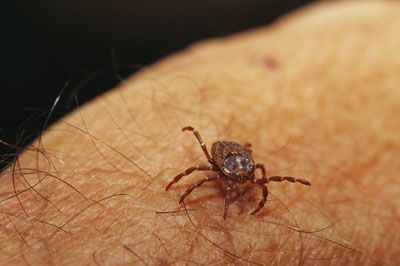
Nature's great — it's good for you. We can all benefit from a nice walk in the woods or a round of badminton in the backyard. But hanging out outdoors can be hazardous, and one growing risk seems to be getting sick from a bug bite.
Areport, published May 4, 2018 by the Centers for Disease Control and Prevention (CDC), finds that cases of vector-borne diseases — those carried from host to host (like humans and other animals) by biting insects, mainlyticksand mosquitoes — tripled in the U.S. between 2004 and 2016, ballooning from 27,300 cases to 96,000 cases in a little over a decade. During this time, nine previously unknown vector-borne pathogens were discovered, including tick-bornebabesiosisand mosquito-borneZikaandchikungunyaviruses.
Advertisement
More than 60 percent of these vector-borne diseases were caused by ticks — for instance, cases of莱姆病and other tick-borne illnesses doubled over the study period, from about 22,500 cases in 2004 to 48,600 in 2016. Although not as manymosquito-borne diseases like the Zika andWest Nileviruses were reported during the 13-year period, what interested the CDC researchers was the viruses sudden spike in the year 2012. In one year, almost 14,000 cases of mosquito-borne diseases, mostly West Nile, were reported, up from only 4,400 the year before. By 2016, more than 47,000 mosquito-borne diseases were reported in the U.S., but this time it was mostly Zika virus. The CDC also reports that since vector-borne diseases commonly go unreported, the rise in cases of these illnesses could be much greater than estimated by this study.
Several factors most likely play into the rise in vector-borne illness in the U.S., but you can probably guess the main culprit. Rising global temperatures have both expanded tick season and made it possible for these blood-sucking arachnids to live farther north than their former natural range would allow. In addition, people in the U.S. are doing more international travel and living in closer proximity to wild animals, which are often, in addition to humans, hosts to these diseases.
So, vector-borne diseases are out there, but what do we do to protect ourselves? The CDC suggests wearing insect repellent and long sleeves and pants when you go outside for those healthful walks and badminton tourneys. And go to the doctor if you feel bad! Early detection not only helps us understand the scope of our new vector-borne disease problem, it also helps you get better much faster.
Learn more about tick-borne disorders in "Everything You Need to Know About Lyme Disease and Other Tick-Borne Disorders" by Karen Vanderhoof-Forschner. HowStuffWorks picks related titles based on books we think you'll like. Should you choose to buy one, we'll receive a portion of the sale.
Advertisement





